This article was written by educator and experience designer, Caitlin Krause as part of a series of Design Retrospectives on the prototypes commissioned by Cooper Hewitt’s Interaction Lab for the Activating Smithsonian Open Access Challenge.
When ScienceVR co-founders Yen-Ling Kuo, Jackie Lee, and I began to approach the design process for the Activating Smithsonian Open Access (ASOA) open call, we prioritized creating meaningful interactions with the open source artifacts in the Smithsonian Open Access collection. The key word in the program announcement that stood out was the verb “activate.” What does it truly mean to “activate”? As an author, educator, and experience designer, I began to think about the nature of encountering artifacts, and what each of us does when we visit a museum—acting and activating. How might a curious learner be transported through imagination and wonder?
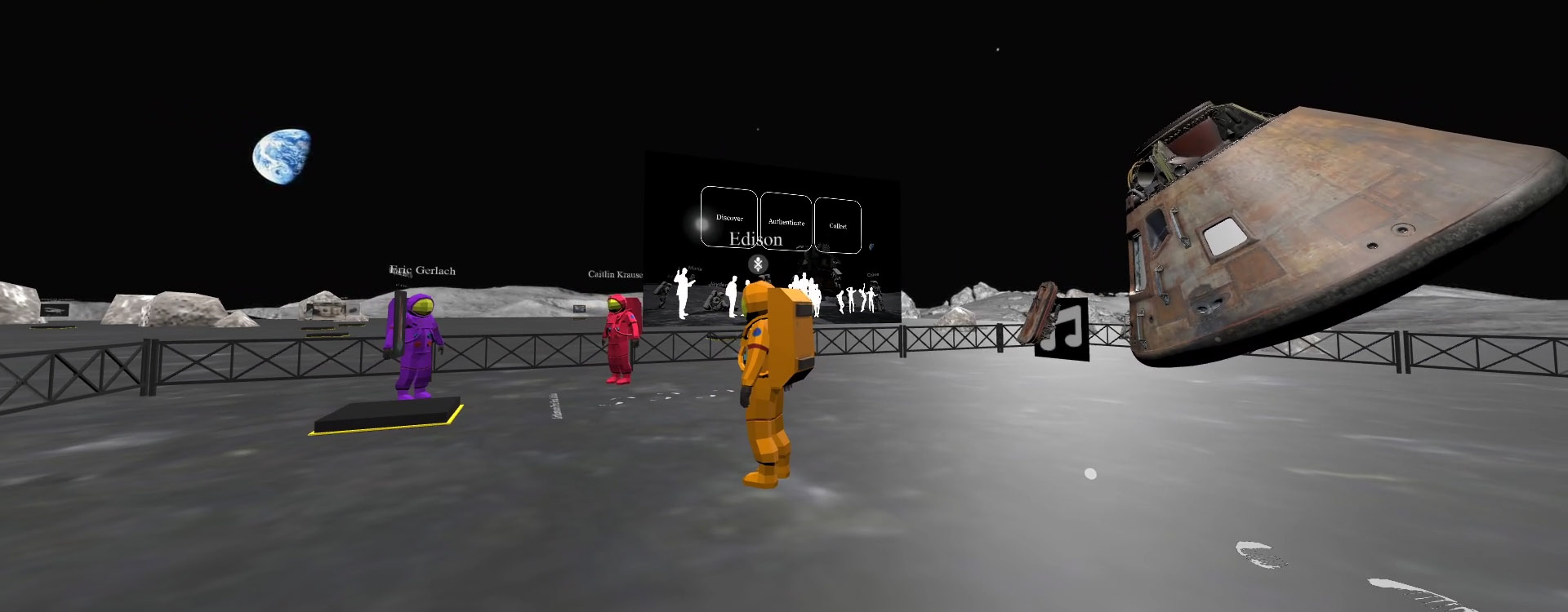
Three astronaut avatars meeting at the game “start zone.”
Artifacts are simply objects that run the risk of meaning nothing without context, without a story, and a way to engage and make meaning out of them. We looked through all of the open access assets available, and decided to draw from the space artifacts primarily associated with the Apollo 11 mission to build our version of a virtual “moon museum,” the game that ultimately became ScienceVR Treasure Hunt. In addition to our team’s passion for space travel, we saw a great opportunity to invite visitors to have more agency and direct contact with the artifacts in a 3D webXR setting, through creating a learning experience that feels like a game that’s both fun and fun-ctional (aka educational).
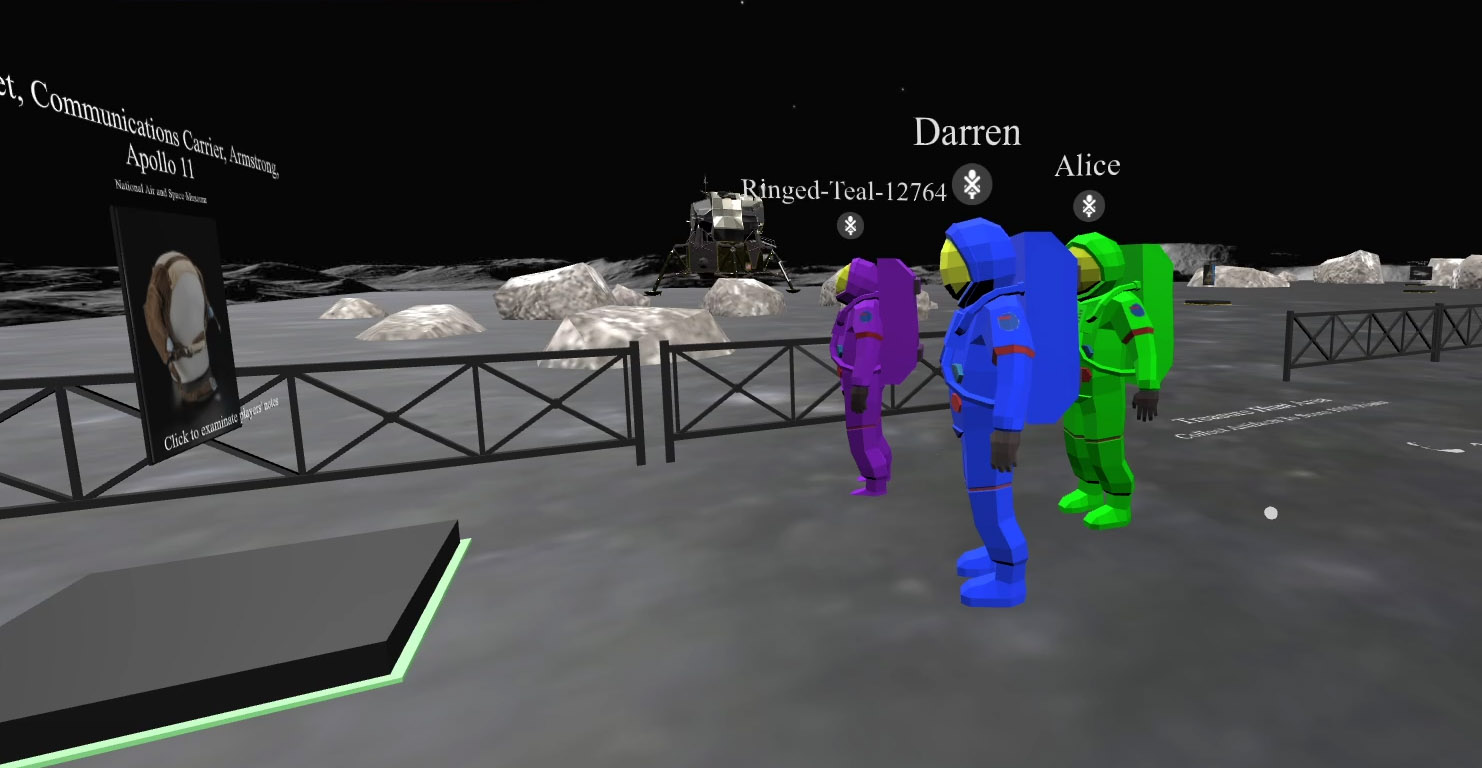
The astronauts encounter a communications device and begin to investigate.
There’s a wealth of support for the dual priorities of rigor and fun in learning game design. Celia Hodent, author of The Psychology of Video Games (2020), says “My subjective opinion of video games was (and still is) that they’ve allowed me to explore new worlds, solve puzzles, learn to persevere, and to simply have fun.” Ralph Koster in A Theory of Fun for Game Design (2005) urges “Go play! In poetry and prose, play in wit, play in form, play in association, illogic, metaphor, allusions.” For Koster, play is healthy exercise for the brain. Fun can be found in rigor, by “mentally mastering problems . . . and problems can be aesthetic, physical, or social.” He advocates for games to encourage a sense of flow, or “learning in a context where there is no pressure.” Games allow players to release inhibitions and to stretch and grow by reaching even better connection with the subject material, themselves, and with fellow players.
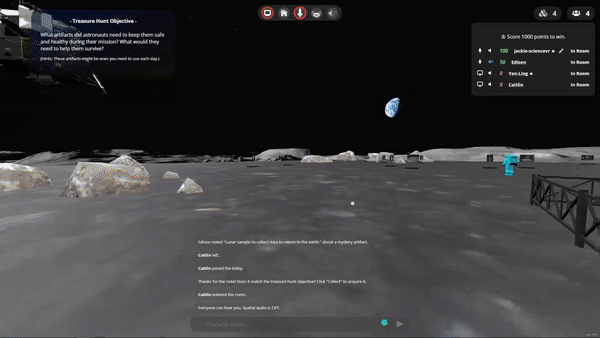
A short video clip of the gameplay, navigating around the lunar landscape.
Teaching middle school and high school humanities—English and history—for over a decade, I witnessed my students engage more meaningfully when I framed learning methodology in a social game structure. Adolescents have brains that are developing socially, influenced by interactions with others (both adults and peers) around them. Games can help give players a sense of agency and authority by encouraging them to develop their “systems thinking,” deepening their understanding of non-linear interconnectedness while making a learning transfer back to related knowledge and understanding. In this way, well-designed gameplay can offer a constructivist approach that encourages and supports learning outcomes.
For ASOA, we set out to design a game that would provide learners the chance to have fun, giving each object a story with meaning and relevance, all while having positive social interactions with peers and mentors. We focused specifically on designing a game for middle school and high school aged players, in part because this is a time when meaningful learning experiences can have a tremendous impact on learning outcomes and overall wellbeing. For teens, stress and anxiety has been on the rise for years, now exacerbated by COVID, and there is an enduring need for positive social connections. As the story designer on our team, I was guided by the tenets of gamification and social and emotional learning (SEL) to transform the digital learning space into a place of curiosity, connection, and delight.
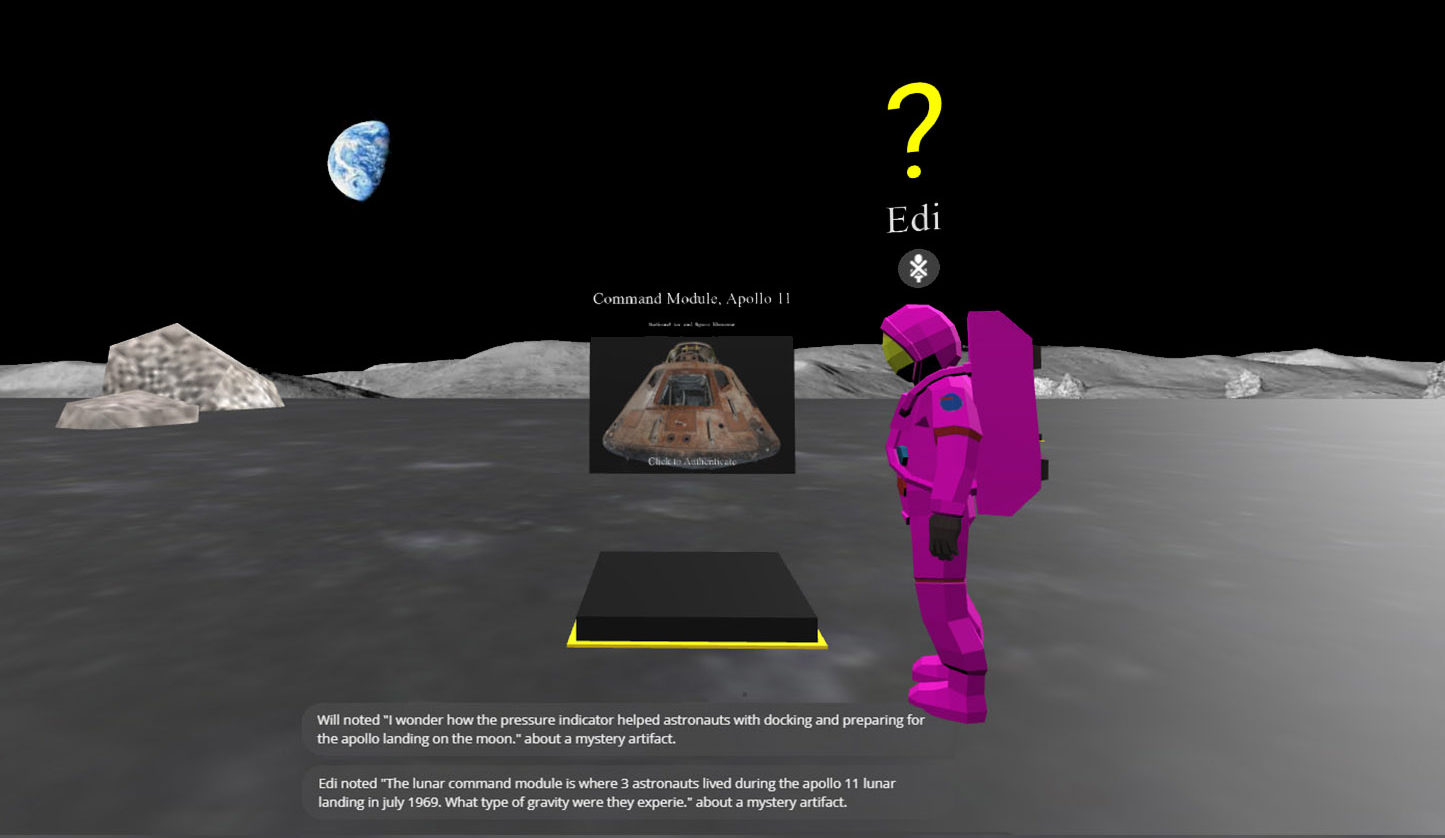
Investigation, close observation, and open wondering through shared note-taking is part of the social and emotional learning elements in the game design.
When first imagining what we might create, the idea for a treasure hunt motif came from Jackie’s middle school-aged son, Edison, who imagined how much fun he and his friends could have on quests to discover Smithsonian treasures in a virtual environment. His enthusiasm motivated us from the beginning. Jackie and Yen-Ling put their developer skills to work, building the scoring system on top of the multiplayer WebXR platform Mozilla Hubs. When we began to find ourselves transported back to a middle-school mindset by the scoring and gameplay, we knew we were onto something.
Games are meaning-makers for the brain, and players can lose themselves in imagination, wonder, and open creative mindsets. When I approach game design, I build in what Seymour Papert called the “4 P’s”: projects, passion, peers and play, which now guide the Lifelong Kindergarten Lab at MIT’s Media Lab led by Mitch Resnick. When people are playing games, they engage and find joy in the learning process, while also feeling a sense of motivation. There’s both extrinsic and intrinsic motivation involved, as learners can feel positively influenced in a game to pursue a “prize” as well as the internal rush of feeling they played the game well. They exerted effort, and the rigor itself is part of the reward. When games are approached in a cooperative way, the meaning and sense of camaraderie, social learning, healthy risk, and reward expands.
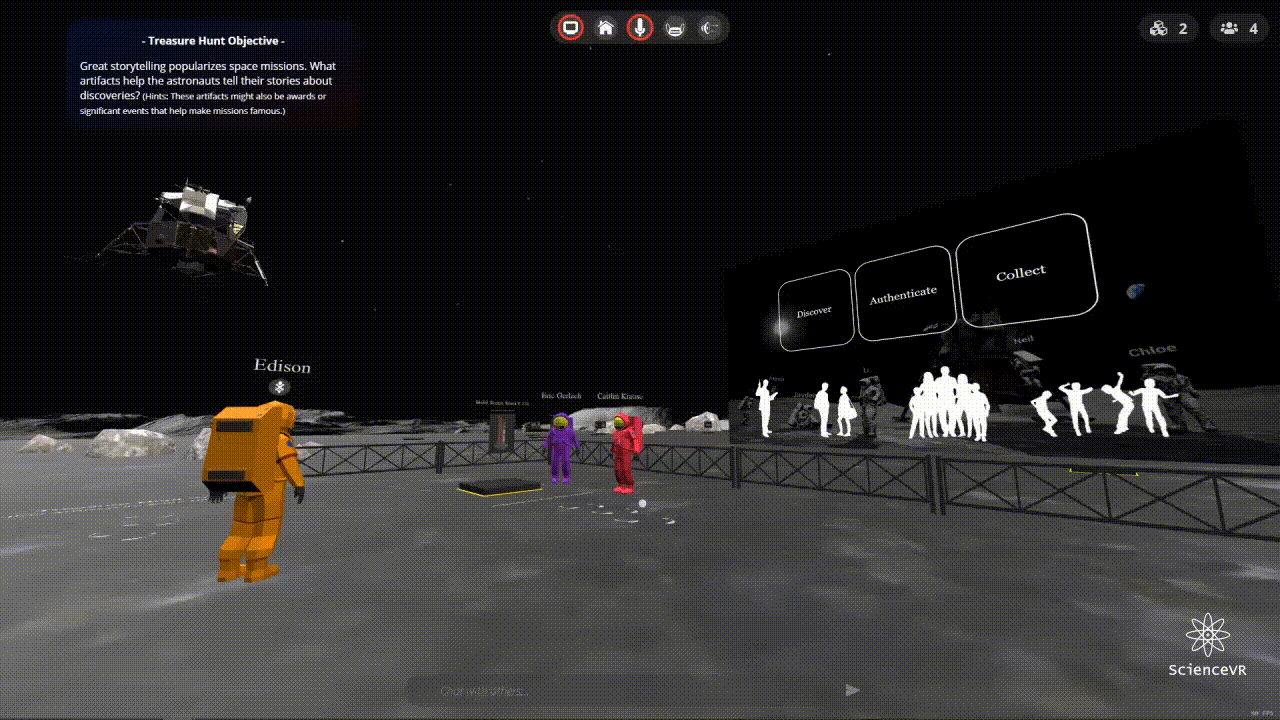
Here, players are getting used to the game mechanics. The start zone features a lunar landing module in the background, and an artifact to practice the three-part “discover, authenticate, collect” game structure.
We knew our game for the ASOA challenge needed to be social, cooperative and inquiry-driven. This led me to invent a 3-part model for the gameplay: Discover, Authenticate, Collect. The basic premise of the game would be that a player acts as a museum curator-in-training. They enter landscapes where artifacts are hidden, and must search to discover them in a treasure hunt style. Once they find an artifact, they need to observe it, slowing down to notice details and reflect in a lab journal, interacting with peers to ask questions and share observations. They then authenticate its relevance to the mission. I’ve been a part of the Out of Eden Learn project spearheaded by Pulitzer Prize winner Paul Salopek, a proponent of using slow journalism and the power of the pause to allow deeper storytelling to emerge. I wanted to encourage these slow observations in our WebXR digital learning space, drawing inspiration from the Right Question Institute’s emphasis on active open-ended questions and Harvard’s Project Zero’s Visible Thinking Routines.
Project Zero uses the “See, Think, Wonder” framework, for example, to encourage noticing. Our digital game uses similar question frames to prompt players to share what they see, think, and wonder about, coming up with new ideas about each artifact through the power of pausing, noticing, and appreciating. This process incorporates mindfulness, in paying attention and focusing on details with a sense of open-mindedness. Players can read each other’s notes, share observations, and then decide if they will choose to add the found artifacts to a curated set that appears later in a digital museum. When a player collects an artifact, they are able to see and learn from others’ perspectives.
Our “moon museum” is far from what a visitor might expect, as marble floors have been swapped for a lunar surface, and there’s an animation of the Apollo 11 Eagle landing sequence to welcome treasure hunters to the interactive digital environment. We chose Apollo 11 as the theme for our prototype because it is part of the curriculum in most middle and high school science classes.

Two players, as astronaut avatars, discovering and authenticating different artifacts.
While some games encourage players to speed up in order to reach a finish line first, it’s our hope that our cooperative SEL game encourages each player to slow down, connect, reflect, and experience a bit of wonder and awe. What can happen when learners in virtual digital games are also encouraged to role-play, to communicate, to experiment, and to hone in on recognizing details?
ScienceVR Treasure Hunt is currently in beta mode, using artifacts from the Apollo 11 space mission to guide this first foray into “discover, authenticate, and collect.” We are currently offering guided tours and collecting qualitative feedback and data about the user experience in the game. If you’re curious, come visit us online and try it out!
To join us for a deeper dive, come to an open house in the moon museum on February 25 at 4pm EST, where visitors can learn more about ScienceVR Treasure Hunt: Apollo 11 Space Mission Edition and have a chance to play together. Register here to join for this free event.
About the Author
Caitlin Krause focuses on the intersection of technology, innovation, and well-being, and founded the studio and consultancy MindWise in 2015. She teaches about the subject at Stanford University, is a Senior Strategist at the Virtual World Society, and is a creative producer for ScienceVR. In September of 2020 she released the book Designing Wonder: Leading Transformative Experiences in VR. Caitlin has created and run numerous collaborative experiences in social XR, fusing presence, storytelling, and emotional intelligence. After two decades of teaching, she authored Mindful By Design (Corwin Press, 2019) helping individuals and teams navigate complexity and change, prioritizing mindful wellbeing, design, and imagination.
About Activating Smithsonian Open Access (ASOA)
Created by Cooper Hewitt’s Interaction Lab and made possible by Verizon 5G Labs, Activating Smithsonian Open Access fosters a new approach to activating museum collections by expanding access to deep engagement for people of many abilities and interests worldwide, and supporting creative technology teams in the process. Each team received $10,000 to build a functioning prototype of a new digital interaction that enables play and discovery with 2D and 3D digitized assets from the Smithsonian’s Open Access collections and will retain ownership of all intellectual property developed from the program.
About Cooper Hewitt’s Interaction Lab
The Interaction Lab is an embedded R&D program driving the reimagining of Cooper Hewitt’s audience experience, across digital, physical, and human interactions. Since its Fall 2019 launch, the Lab has injected new ideas into the museum’s work through internal workshopping and strategy, a highly participatory public program series merging interactive design and museum practice, and a commissioning program that engages the design community as creative collaborators in creating the next wave of the Cooper Hewitt experience.
Further Reading References:
Farber, M., Williams, M. K., Mellman, L., & Yu, X. (2020). Systems at Play: Game Design as an Approach for Teen Self-Expression. Journal of Games, Self & Society. Carnegie Mellon University: ETC Press. 2(1), 40-84.
Horowitz, J. M., & Graf, N. (2019, February). Most U.S. teens see anxiety and depression as a major problem among their peers. Pew Research Center. Retrieved from https://www.pewresearch.org/social-trends/2019/02/20/most-u-s-teens-see-anxiety-and-depression-as-a-major-problem-among-their-peers/
Resnick, M. (2017). Lifelong kindergarten: Cultivating creativity through projects, passion, peers, and play. Cambridge, MA: MIT Press.
Papert, S. (1980). Mindstorms: Children, computers, and powerful ideas. New York, NY: Basic Books.